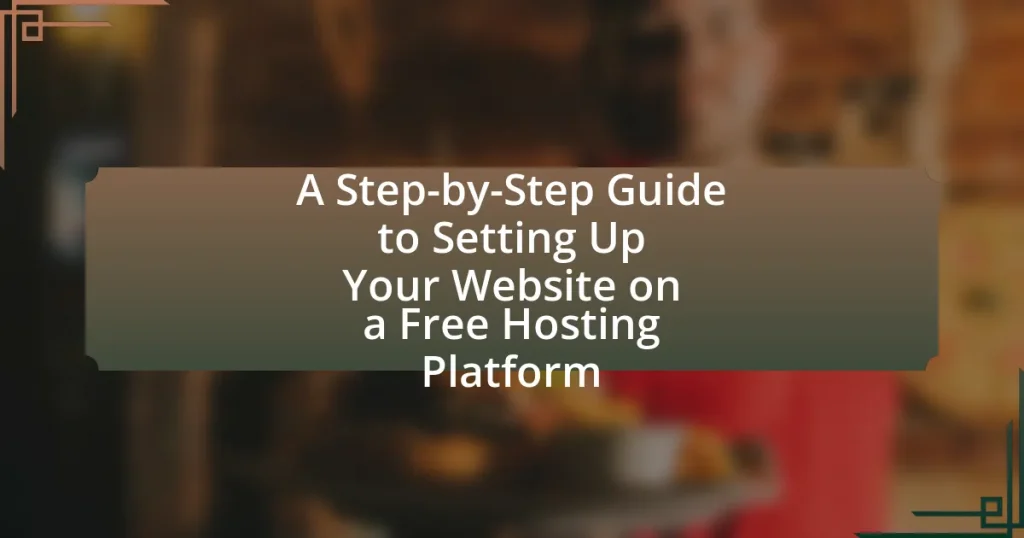The article provides a comprehensive guide on setting up a website using a free hosting platform, detailing the features, limitations, and differences between free and paid hosting options. It outlines the essential steps for selecting a suitable platform, creating an account, designing the website, and publishing it. Key considerations such as storage, bandwidth, customer support, and performance monitoring are discussed, along with tips for optimizing visibility and maintaining the website. Popular free hosting platforms like WordPress.com, Wix, and Weebly are highlighted, offering insights into their specific features and advantages for beginners and small businesses.

What is a Free Hosting Platform?
A free hosting platform is a service that allows individuals or organizations to host their websites without incurring any costs. These platforms typically provide limited resources, such as storage space and bandwidth, and may include advertisements on the hosted sites. According to a report by HostingAdvice, many free hosting services, like WordPress.com and Wix, offer basic features that enable users to create and manage websites without financial investment, making them accessible for beginners and small projects.
How do free hosting platforms differ from paid options?
Free hosting platforms differ from paid options primarily in terms of features, reliability, and support. Free hosting typically offers limited storage, bandwidth, and fewer customization options, while paid hosting provides more resources, enhanced performance, and advanced features like SSL certificates and domain registration. Additionally, free hosting often includes advertisements and lacks customer support, whereas paid services usually offer dedicated support and a more professional experience. For instance, a study by HostingAdvice in 2021 indicated that 70% of users experienced downtime with free hosting compared to only 10% with paid services, highlighting the reliability gap.
What are the limitations of using free hosting platforms?
Free hosting platforms have several limitations, including restricted storage space, limited bandwidth, and lack of customer support. These platforms often impose constraints on the amount of data users can store and the traffic their websites can handle, which can lead to slow loading times and potential downtime. Additionally, free hosting services frequently display advertisements on users’ sites, which can detract from the user experience and brand image. Security features are often minimal, increasing vulnerability to cyber threats. Furthermore, users typically do not have access to custom domain names, which can hinder professional branding efforts.
What features are commonly offered by free hosting platforms?
Free hosting platforms commonly offer features such as limited storage space, bandwidth, and subdomain usage. These platforms typically provide a basic website builder, allowing users to create simple sites without coding knowledge. Additionally, they often include templates for design, basic security measures, and customer support, albeit with restrictions compared to paid services. For instance, platforms like WordPress.com and Wix provide free plans that include these features, enabling users to launch websites with minimal investment.
Why should you consider using a free hosting platform?
Using a free hosting platform is beneficial because it allows individuals and small businesses to establish an online presence without incurring costs. Free hosting platforms typically offer essential features such as website builders, templates, and basic storage, making it accessible for users with limited technical skills or budget constraints. According to a survey by HostingAdvice, 70% of small businesses reported that cost is a significant factor in their choice of web hosting, highlighting the importance of free options for startups and entrepreneurs.
What are the advantages of starting with a free hosting platform?
Starting with a free hosting platform offers cost savings, allowing users to launch their websites without financial investment. This is particularly beneficial for individuals or small businesses testing ideas or building a portfolio. Additionally, free hosting platforms often provide user-friendly interfaces and templates, enabling quick setup and ease of use for beginners. According to a 2021 survey by HostingAdvice, 70% of new website owners prefer free hosting to minimize initial costs while exploring their online presence.
How can a free hosting platform benefit beginners?
A free hosting platform can benefit beginners by providing them with an accessible way to launch their websites without incurring costs. This allows newcomers to experiment with web development, design, and content creation without financial risk. According to a survey by HostingAdvice, 70% of new website owners prefer free hosting options to learn and test their ideas before investing in paid services. This hands-on experience is crucial for skill development and understanding the basics of website management.

How do you choose the right free hosting platform?
To choose the right free hosting platform, evaluate your specific needs such as storage, bandwidth, and ease of use. Different platforms offer varying features; for instance, some may provide limited storage while others offer unlimited bandwidth. Research user reviews and expert comparisons to identify reliable options, as platforms like WordPress.com and Wix are often recommended for their user-friendly interfaces and robust support. Additionally, consider the platform’s uptime reliability and customer support availability, as these factors significantly impact your website’s performance and accessibility.
What factors should you consider when selecting a free hosting platform?
When selecting a free hosting platform, consider factors such as storage space, bandwidth limits, uptime reliability, and customer support. Storage space determines how much data you can store, while bandwidth limits affect how much traffic your site can handle. Uptime reliability is crucial, as a platform with high uptime ensures your website remains accessible; for instance, a platform with 99.9% uptime is generally considered reliable. Customer support is important for resolving issues quickly; platforms that offer 24/7 support are preferable. Additionally, check for any hidden fees or restrictions on features, as these can impact your website’s performance and growth potential.
How important is customer support in a free hosting platform?
Customer support is crucial in a free hosting platform because it directly impacts user experience and problem resolution. Users often encounter technical issues or limitations that require assistance, and effective customer support can facilitate quick solutions, enhancing user satisfaction. According to a survey by Zendesk, 82% of consumers have stopped doing business with a company due to poor customer service, highlighting the importance of responsive support in retaining users on free platforms.
What role does storage and bandwidth play in your choice?
Storage and bandwidth are critical factors in choosing a free hosting platform for a website. Adequate storage ensures that all website files, including images, videos, and databases, can be accommodated without running out of space, which can lead to site downtime or performance issues. Bandwidth, on the other hand, determines the amount of data that can be transferred to and from the website, affecting loading speeds and user experience. For instance, a platform offering at least 1 GB of storage and 10 GB of monthly bandwidth is often considered sufficient for small to medium-sized websites, as it allows for reasonable traffic and content management without incurring additional costs.
Which popular free hosting platforms are available?
Popular free hosting platforms include WordPress.com, Wix, Weebly, and GitHub Pages. WordPress.com offers a user-friendly interface and a variety of themes, making it suitable for blogs and websites. Wix provides drag-and-drop functionality, allowing users to create visually appealing sites without coding. Weebly also features a simple drag-and-drop builder and is known for its e-commerce capabilities. GitHub Pages is ideal for developers, enabling them to host static websites directly from their GitHub repositories. These platforms are widely recognized for their accessibility and features, making them popular choices for individuals and small businesses looking to establish an online presence without incurring costs.
What are the key features of WordPress.com?
The key features of WordPress.com include a user-friendly interface, customizable themes, built-in social sharing, and integrated SEO tools. The platform allows users to create and manage websites without needing coding skills, making it accessible for beginners. Customizable themes enable users to personalize their site’s appearance, while built-in social sharing facilitates content distribution across various platforms. Additionally, integrated SEO tools help improve site visibility in search engines, enhancing overall online presence. These features collectively support users in effectively setting up and managing their websites on a free hosting platform.
How does Wix compare to other free hosting platforms?
Wix offers a more user-friendly interface and extensive design flexibility compared to other free hosting platforms like WordPress.com and Weebly. While Wix provides a drag-and-drop builder that simplifies website creation, WordPress.com requires more technical knowledge for customization. Additionally, Wix includes a wide range of templates and apps, enhancing functionality without needing coding skills. In contrast, platforms like Weebly may have fewer design options and features. According to a 2023 survey by Website Builder Expert, 70% of users preferred Wix for its ease of use and design capabilities over other free hosting services.

What are the steps to set up your website on a free hosting platform?
To set up your website on a free hosting platform, follow these steps: First, choose a free hosting provider such as WordPress.com, Wix, or Weebly. Next, create an account by providing your email and setting a password. After account creation, select a template or theme that suits your website’s purpose. Then, customize your website by adding content, images, and any necessary features. Finally, publish your website by clicking the publish button, making it accessible to the public. These steps are validated by the user-friendly interfaces and guided processes offered by popular free hosting platforms, ensuring ease of use for beginners.
How do you create an account on a free hosting platform?
To create an account on a free hosting platform, visit the website of the chosen hosting provider and locate the “Sign Up” or “Create Account” button. After clicking, fill out the registration form with required information such as your email address, username, and password. Many platforms will send a verification email to confirm your account; follow the instructions in that email to activate your account. This process is standard across various free hosting services, ensuring users can easily access their hosting features after registration.
What information do you need to provide during registration?
During registration, you typically need to provide personal information such as your name, email address, and a password. This information is essential for creating an account and ensuring secure access to the hosting platform. Additionally, some platforms may require you to provide a username or select a domain name for your website. These requirements are standard across various free hosting services to facilitate user identification and website management.
How do you verify your account after registration?
To verify your account after registration, you typically need to check your email for a verification link sent by the hosting platform. Clicking this link confirms your email address and activates your account. This process is standard across many platforms to ensure the validity of user accounts and prevent unauthorized access.
What are the steps to design your website?
To design your website, follow these steps: first, define your website’s purpose and target audience. This foundational step guides the design process and ensures the website meets user needs. Next, create a sitemap to outline the structure and navigation of your website, which helps in organizing content effectively. After that, choose a website builder or content management system that aligns with your technical skills and design preferences, such as WordPress or Wix.
Then, select a template or theme that reflects your brand identity and is responsive for mobile devices. Following this, customize the design elements, including colors, fonts, and images, to create a cohesive look. Next, develop the content for each page, ensuring it is engaging and optimized for search engines. Finally, test the website for functionality and user experience before launching it to ensure everything works correctly and meets your design goals.
These steps are validated by industry best practices in web design, which emphasize user-centered design and effective content organization.
How do you choose a template or theme for your website?
To choose a template or theme for your website, first identify your website’s purpose and target audience. This clarity helps in selecting a design that aligns with your goals, such as showcasing a portfolio, blogging, or e-commerce. Next, evaluate the template’s responsiveness, ensuring it displays well on various devices, as 54.8% of global website traffic comes from mobile devices according to Statista. Additionally, consider customization options and ease of use; templates that allow for easy modifications can save time and enhance user experience. Finally, check for compatibility with essential plugins and SEO features, as these elements significantly impact your website’s performance and visibility.
What customization options are available for your website design?
Customization options for website design include template selection, color schemes, font choices, layout adjustments, and the addition of custom graphics or logos. These options allow users to tailor the appearance and functionality of their website to align with their brand identity and user experience goals. For instance, many free hosting platforms offer a variety of pre-designed templates that can be modified, enabling users to change colors and fonts to match their branding. Additionally, users can often rearrange layout elements and incorporate unique images or logos, enhancing the site’s visual appeal and personal touch.
How do you publish your website once it’s ready?
To publish your website once it’s ready, you need to upload your website files to a web hosting service. This process typically involves using an FTP client or the hosting provider’s file manager to transfer your HTML, CSS, JavaScript, and other files to the server. Many free hosting platforms, such as GitHub Pages or Netlify, allow you to publish your site by simply pushing your code to a repository or connecting your project folder. For example, GitHub Pages automatically deploys your site when you push changes to the main branch of your repository. This method ensures that your website is accessible online, allowing users to visit it through a web browser.
What steps are involved in publishing your website on a free hosting platform?
To publish your website on a free hosting platform, follow these steps: First, choose a free hosting provider such as WordPress.com, Wix, or GitHub Pages. Next, create an account on the selected platform by providing necessary information like your email and password. After account creation, select a template or theme that suits your website’s purpose. Then, use the platform’s website builder to customize your site by adding content, images, and other elements. Once your website is ready, preview it to ensure everything looks correct. Finally, publish your website by clicking the designated publish button, making it accessible to the public. These steps are standard across most free hosting platforms, ensuring a straightforward process for users.
How can you test your website before going live?
To test your website before going live, conduct a series of checks including functionality testing, usability testing, performance testing, and security testing. Functionality testing ensures all features work as intended, such as forms, links, and navigation. Usability testing assesses the user experience by evaluating how easily visitors can navigate and interact with the site. Performance testing measures loading speed and responsiveness under various conditions, while security testing identifies vulnerabilities that could be exploited. These testing methods are essential to ensure a smooth launch and a positive user experience.

What are common challenges when using a free hosting platform?
Common challenges when using a free hosting platform include limited storage and bandwidth, lack of customer support, and potential security vulnerabilities. Free hosting services often impose strict limits on the amount of data and traffic a website can handle, which can hinder growth and performance. Additionally, these platforms typically offer minimal or no technical support, making it difficult for users to resolve issues quickly. Security is also a concern, as free hosting providers may not implement robust security measures, leaving websites vulnerable to attacks.
What issues might you encounter during setup?
During setup, you might encounter issues such as limited storage space, slow loading times, and lack of customer support. Free hosting platforms often impose restrictions on bandwidth and storage, which can hinder website performance and scalability. Additionally, these platforms may not provide timely assistance for technical problems, leading to prolonged downtime. According to a study by HostingAdvice, 70% of users reported dissatisfaction with the support services of free hosting providers, highlighting the potential challenges during setup.
How can you troubleshoot common setup problems?
To troubleshoot common setup problems, first identify the specific issue by checking error messages or symptoms. For example, if a website fails to load, verify the internet connection and ensure the domain is correctly pointed to the hosting server. Additionally, review configuration settings, such as file permissions and database connections, to ensure they are set up correctly. According to a study by the Web Hosting Industry Association, 70% of website issues stem from misconfigurations, highlighting the importance of thorough checks in the setup process.
What are the best practices for avoiding common pitfalls?
To avoid common pitfalls when setting up a website on a free hosting platform, it is essential to choose a reliable hosting provider that offers adequate support and resources. Selecting a provider with positive user reviews and a proven track record can prevent issues related to downtime and limited functionality. Additionally, it is crucial to understand the limitations of free hosting services, such as bandwidth restrictions and lack of custom domain options, which can hinder website performance and branding. Regularly backing up website data is another best practice, as it ensures recovery in case of data loss or technical failures. According to a study by the Online Backup Market, 30% of users experience data loss, highlighting the importance of backups. Lastly, optimizing website content for speed and mobile responsiveness can enhance user experience and improve search engine rankings, as Google reports that 53% of mobile users abandon sites that take longer than three seconds to load.
How can you maintain your website on a free hosting platform?
To maintain your website on a free hosting platform, regularly update your content, monitor website performance, and ensure backups are in place. Regular content updates keep your site relevant and engaging, which can improve search engine rankings. Monitoring performance involves checking loading speeds and uptime, as free hosting services may have limitations that affect user experience. Additionally, creating backups protects your data from potential loss due to service outages or technical issues, which is crucial since free hosting platforms often lack robust support.
What regular updates should you perform on your website?
Regular updates to perform on your website include content updates, software updates, security checks, and performance monitoring. Content updates ensure that information remains relevant and engaging, which can improve user experience and SEO rankings. Software updates, including plugins and themes, are crucial for maintaining functionality and security, as outdated software can lead to vulnerabilities. Security checks, such as scanning for malware and ensuring SSL certificates are up to date, protect user data and maintain trust. Performance monitoring, including checking loading speeds and broken links, helps optimize user experience and can impact search engine rankings. Regularly performing these updates is essential for maintaining a functional, secure, and user-friendly website.
How can you monitor your website’s performance effectively?
To monitor your website’s performance effectively, utilize web analytics tools such as Google Analytics, which provides real-time data on user behavior, traffic sources, and conversion rates. These tools allow you to track key performance indicators (KPIs) like page load time, bounce rate, and user engagement metrics. For instance, Google Analytics reported that websites with optimized load times can see a 20% increase in user engagement, highlighting the importance of performance monitoring. Additionally, employing tools like GTmetrix or Pingdom can help assess site speed and identify areas for improvement, ensuring that your website remains efficient and user-friendly.
What tips can help you succeed with a free hosting platform?
To succeed with a free hosting platform, prioritize selecting a reliable provider that offers essential features like uptime guarantees and customer support. Research shows that platforms with at least 99.9% uptime significantly enhance user experience and site accessibility. Additionally, optimize your website for speed and performance by minimizing image sizes and using efficient coding practices, as faster loading times improve user retention and search engine rankings. Regularly back up your website data to prevent loss, as many free hosting services do not provide automatic backups. Engage with the community or forums related to your hosting platform for tips and troubleshooting advice, which can enhance your understanding and usage of the service.
How can you optimize your website for better visibility?
To optimize your website for better visibility, focus on implementing effective SEO strategies. This includes conducting keyword research to identify relevant terms that potential visitors are searching for, and then incorporating these keywords naturally into your website’s content, titles, and meta descriptions. Additionally, improving site speed and mobile responsiveness enhances user experience, which is a ranking factor for search engines. According to Google, 53% of mobile users abandon sites that take longer than three seconds to load, highlighting the importance of speed. Furthermore, creating high-quality, engaging content that encourages backlinks can significantly boost your site’s authority and visibility.
What resources are available for learning more about website management?
Comprehensive resources for learning about website management include online courses, tutorials, and documentation. Platforms like Coursera and Udemy offer structured courses on website management, covering essential topics such as content management systems, SEO, and analytics. Additionally, websites like W3Schools and Mozilla Developer Network provide extensive tutorials and documentation on web technologies and best practices. These resources are widely recognized for their quality and depth, making them reliable for anyone looking to enhance their website management skills.
